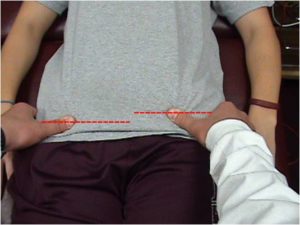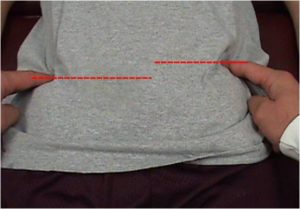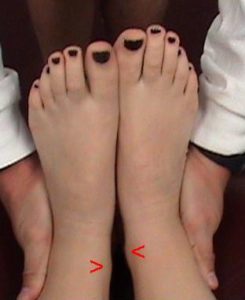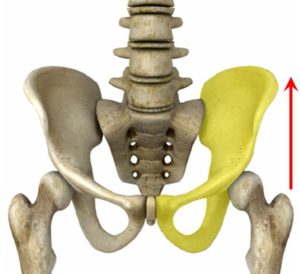An Upslip of half of the pelvis is an extremely common injury for athletes. It involves half of the pelvis (usually the left side) moving upward relative to the opposing side. This has a ripple effect on the rest of the lower body. It can change leg length, place a stretch on specific muscles, and provide an altered neurological feedback loop. All of this will impact you or your athlete’s ability to run, jump, land, compete, and stay injury free.
How does it happen?
Most athletes and active individuals have no idea that they are Upslipped and how it happened. It can happen for a variety of reason. Here are some typical things that lead to an upslip:
- Playing on an uneven surface – If an athlete is playing on an unpredictable surface, they will have difficulty knowing where to place their foot to avoid holes or high spots. We see this a lot younger athletes or recreational athletes who compete a lot of fields which aren’t well maintained. Any sudden, unexpected set will have a tendency to forcefully drive one leg upward.
- Running on one side of the road – City streets have a crown to them, which allows the rainwater to flow into the gutter on the sides of the road. If an athletes is constantly running one direction on a road, they are striking on an uneven surface, thus we tend to see small, repetitive changes which may eventually turn into a significant upslip.
- Anatomical Leg Length Inequality – The research shows that 90% of the general population have legs of different lengths. If an athlete has even a small leg length inequality, their pelvis will have have a tendency to Upslip and shorten one limb to make up for the difference.
- Scoliosis – The unnatural lateral curvature of the spine will definitely have an impact on the entire spine and pelvis due to the limited lateral flexion on one side and tendency to load more on one leg than the other.
- Falling hard on one hip – Depending upon the sport, athletes may fall or get knocked down hard, landing on one hip, forcing it into an acute, sudden upslipped position.
- Repetitive jumping on a single leg – Sports such as basketball and volleyball will predispose athletes to upslips because of their repetitive jumping and landing on a single leg. Many of these athletes will tend to be more dominant on one leg than the other, thus they will usually use that leg and will place unnatural shear forces on that side of the pelvis.
Characteristics
An athlete who has an upslip will present with pain and irritation, usually in the lower extremity and/or low back, and usually only present on one side of the body. Many clinicians get frustrated by “chronic” lower extremity injuries because they never get to the true cause of the problem when they stay focused on the actual site of pain. This shows a lack of understanding of biomechanics.
While it would be nice to be able to always associate one or two symptoms with lumbopelvic dysfunction, it is just too complex of an injury to do that. Every athlete will present differently as their body finds the path of least resistance. The old saying holds true to that you are only as strong as your weakest link. That’s why there is such a broad spectrum of injuries that are associated with lumbopelvic dysfunction. Whenever the body is not symmetrical and one limb is functioning different than the other, there will be a tendency for the body to break down. When it does, it is always the weakest link or somewhere in the path of least resistance.
Looking for more help? Schedule a consultation today!
Evaluation
| The Upslip is assessed by properly putting pelvis in it’s current “neutral” position. For more information on evaluating for lumbopelvic dysfunction, click here.
The Upslip typically has the following characteristics while lying supine:
|
 |
 |
|
 |
Treatment
The treatment of choice for an Upslip is a good pelvic joint mobilization. This is a pretty specialized area of expertise that calls for advanced training. It is beyond the scope of a website discussion and should be left to those who have been educated in this area and have taken the time to perfect such techniques.
If you are an athlete in need of such a treatment, or a clinician who does not possess the skills to correct such an injury, we invite you to contact us to schedule an onsite educational seminar to learn the techniques to correct lumbopelvic dysfunction.
Other options that you want to explore is contacting a local Doctor of Osteopathy (D.O.), Chiropractor, Athletic Trainer, or Physical therapist who may possess the manual skills necessary to fix such an injury
Other treatment options include using a short term heel lift. If a 1/4″ thick wedge is placed under the longer of the two legs, many times you can successfully change the mechanics at the pelvis over the course of 3-7 days enough to correct the upslip.
Many clinicians make the mistake of placing a lift under the short leg, thinking that an anatomical leg length discrepancy exists because they either don’t understand the biomechanical kinetic chain or don’t take the time to look at the pelvis. If you put the lift under the short leg of an athlete with an upslip, you only cement the problem and make symptoms worse and harder to fix.
Keep in mind, though, that you don’t want to cause more problems than were originally present. Thus, if you leave a heel lift in too long, you will see either an increase in symptoms, or create symptoms that weren’t present at the start. So, use a lift as a tool in the overall treatment plan. It is merely a means to an end.
Other things which may be affecting an athlete’s lumbopelvic dysfunction include:
Anterior Rotation
Anatomical Leg Length Inequality
Functional Leg Length Inequality
Looking for more help? Schedule a consultation today!
Back to Home



Can you explain why Is the placement of the wedge under the longer leg is important? Has this been successfully implimented with positive results, or is it only therotically superior to lifting the short leg with an insert?
A heel lift on my short side exacerbated the problem, and I am concerned that the opposite approach will yield equally painful results.
The lift isn’t always the right answer for everyone and some people do better with it in the long leg and some with the short leg. I find that a lot more people do better with it in the long leg to essentially drive the leg up and allow for the shorter leg to drop. But, keep in mind that this isn’t a long term intervention. This is something to wear for a couple of weeks to make a change and hopefully during that time you are able to correct any mobility or stability issues in that time period to be able to make the corrections “stick.”
Would putting a lift on the toe side of the short leg help as well? It seems like my quad is very weak on the short leg side.
Possibly, but I prefer to put the lift on the long side if you know for sure that you have an up slip. Otherwise, I find that you feed the problem and lock it in by putting the lift in the short leg. But, if you try it in the long leg for a couple of weeks and it doesn’t work, then try it in the short leg to see if it is any better. Some people do react differently.
I’ve been dealing with back issues and many other issues for years. I played a lot of soccer and lifted a lot. Only
Now finally a PT told me i have a pelvic upslip on the right with rotation. However they didn’t know the best form of treatment because i was rotated and told me they would ask other PTs before continuing treatment…. what can i do??
I’m sorry you haven’t made more progress on this. My suggestion would be to find a new PT or Chiropractor that can treat it or consider signing up for an online consultation with me and we’ll see what we can get accomplished. Good luck!
How can the issue be remedied? I’ve got an up slip on the left and my chiropractor is struggling to fix it. Is there any information that you can give me so I can forward it to him on how to fix this issue please. I’m desperate because im in pain and unable to do things I used to do before, I can’t even play with my son or pick him up
Look for an osteopath dr. or therapist that can pull your leg down. The chiropractors don’t seem to know or keep you visiting them for money. My chiropractor actually got me into the upslip too! Someone has to fix this. Don’t give up but tell them hey I need this done. Someone has to pull it down you can’t do on your own.